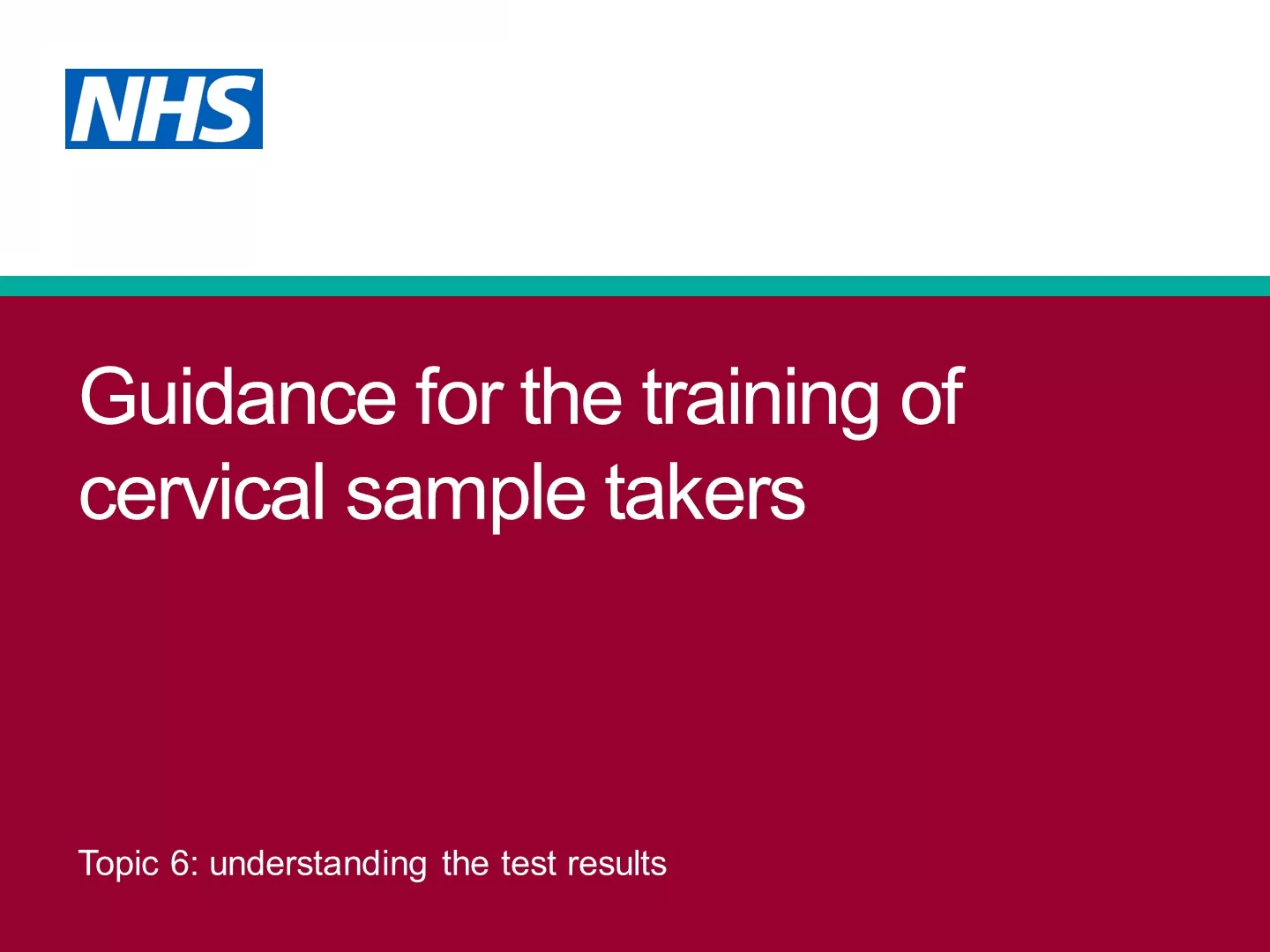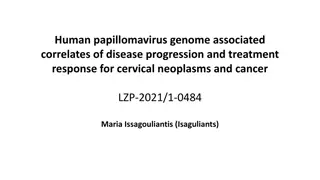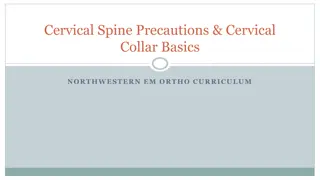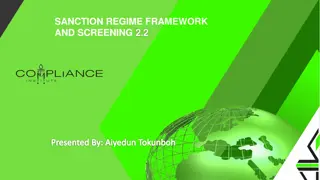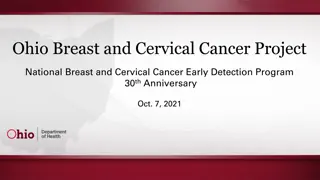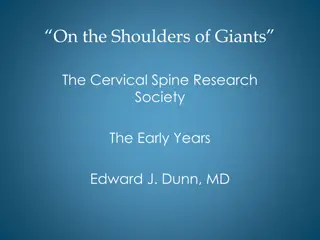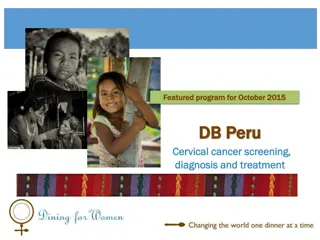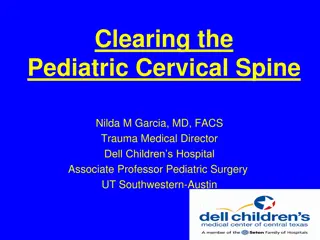Ensuring Equality of Access to Cervical Screening: Key Considerations
Providing guidance on promoting equality of access to cervical screening, the importance of informed choice, information accompanying screening invitations, and checking for understanding to support individuals making informed decisions. Emphasizes the need for culturally sensitive approaches, especially for minority ethnic groups, to address barriers and improve participation in screening programs.
Download Presentation

Please find below an Image/Link to download the presentation.
The content on the website is provided AS IS for your information and personal use only. It may not be sold, licensed, or shared on other websites without obtaining consent from the author.If you encounter any issues during the download, it is possible that the publisher has removed the file from their server.
You are allowed to download the files provided on this website for personal or commercial use, subject to the condition that they are used lawfully. All files are the property of their respective owners.
The content on the website is provided AS IS for your information and personal use only. It may not be sold, licensed, or shared on other websites without obtaining consent from the author.
E N D
Presentation Transcript
Guidance for the training of cervical sample takers Topic 4: equality of access to cervical screening
Note Use these slides in conjunction with the NHS Cervical Screening Programme publication Guidance for the training of cervical sample takers , available at: www.gov.uk/government/publications/cervical-screening-cervical-sample-taker- training 2 Topic 4: equality of access to cervical screening
Making an informed choice Give people the opportunity to make an informed choice about whether or not to attend for cervical screening. They need to understand: why they re being offered screening what happens during the test the benefits and risks of screening the potential outcomes (including types of result, further tests and treatment) what happens to their screening records the opt-out process If a person has the above information about the programme and chooses not to attend screening, this is a valid choice and it must be respected. 3 Topic 4: equality of access to cervical screening
Information accompanying the cervical screening invitation We send an information leaflet with every invitation letter to people called or recalled for routine screening. The leaflet includes an explanation of the possible benefits and risks of cervical screening, what happens during the test, and an explanation of results. The leaflet also informs people about the use of screening records for audit and other purposes. A range of language translations is also available, and alternative formats are available on request (such as braille and audio disks). 4 Topic 4: equality of access to cervical screening
Checking for understanding Sample takers should support informed choice by checking that people who attend for cervical screening: understand the purpose of the cervical screening test and its benefits and risks understand that the procedure involves taking a sample of cells from the cervix to test for high-risk human papillomavirus (hrHPV) infection and cervical cell abnormalities understand it is not a test for diagnosing cervical cancer Sample takers may need to provide additional information and support to people on an individual basis. 5 Topic 4: equality of access to cervical screening
People from minority ethnic groups Many people with a cervix from minority ethnic groups have had negative experiences of cervical screening. Language and cultural differences can affect understanding. Sample takers need to be aware of this and take measures to try and make sure that all people understand the purpose of the screening programme and the procedure for taking the sample. Sample takers should be aware of the importance of: training for primary care teams in cultural awareness in order to acknowledge and understand cultural differences the inclusion of cervical screening in health education for minority ethnic people providing written information about screening in an appropriate language (if possible) language support, if appropriate, for people during sample taking (consent) 6 Topic 4: equality of access to cervical screening
People with a learning disability (1) All people with a cervix aged 25 to 64, whether they are sexually active or not, are entitled to cervical screening. It is the individual s decision if they take up the invitation. The individual can make this decision, or it can be a best interest decision made on their behalf by the appropriate people (such as the person s family, carer and or GP). Sample takers should understand that people with a learning disability: have the same right of access to cervical screening as other eligible people cannot be assumed to be sexually inactive, and even if they are sexually inactive they are still entitled to cervical screening are entitled to accessible information to make their own decision about cervical screening may require reasonable adjustments to support them having screening 7 Topic 4: equality of access to cervical screening
People with a learning disability (2) If person is not able to make a decision themselves, the relevant people can make and record a best interest decision on their behalf. Sample takers should seek specialist advice if necessary. The community learning disability team should be able to support this. An easy-read leaflet is available which has been designed by and for people with a learning disability, for use with their family members or carers. The leaflet aims to help them to make their own decisions about cervical screening and to prepare them for the screening process. www.gov.uk/government/publications/cervical-screening-easy-read-guide An editable, easy-read version of the cervical screening invitation letter is available for use as a template to invite people who have a learning disability. If requested, the easy-read invitation letter should be sent along with the easy guide instead of the standard national invitation letter and leaflet. 8 Topic 4: equality of access to cervical screening
Preparation for people with a learning disability (1) Sample takers should be aware of the importance of: establishing that the person has an understanding of cervical screening preparing the individual to have the test A preliminary visit to the practice or clinic before the individual attends to have the sample taken may be helpful. Scheduling a longer appointment time may also be beneficial, so that the individual has more time to relax and become familiar with their surroundings and with the sample taker. 9 Topic 4: equality of access to cervical screening
Preparation for people with a learning disability (2) When the person attends for a test, the sample taker should check for behavioural signs of compliance with the procedure. This is especially important when screening people for whom it may be difficult to ascertain their level of understanding or consent. There are 6 behavioural signs to look for the person: is relaxed and co-operative is willing to get undressed is willing to be positioned is able to keep still is willing to accept having the speculum passed maintains awareness throughout Lack of co-operation by the person, or distress in any way, must be recognised as the person s choice not to have the test. They should be offered another appointment if they need more preparation and reassurance. 10 Topic 4: equality of access to cervical screening
People with a physical disability Sample takers who work with people with a physical disability should be confident and experienced in taking cervical samples. A person s physical disability may prevent them from achieving a position where the cervix can be visualised and a cervical sample taken. This may include people with severe arthritis or raised body mass index (BMI). The sample taker should consider: access to the venue (can an alternative be offered?) the height of the couch the person s physical limitations the possibility of a home visit the need for assistance seeking specialist advice if necessary The sample taker may need to make special arrangements, for example with the local colposcopy service, to take a sample at a clinic where a hoist is available. 11 Topic 4: equality of access to cervical screening
People who are not registered with a GP The sample taker should: give the individual a copy of the information leaflet in an appropriate format make sure the individual understands the purpose of the test make arrangements for the individual to receive their test result make arrangements for follow-up if the test result is abnormal explain to the individual that they may not receive invitation letters for future screening unless they register with a GP 12 Topic 4: equality of access to cervical screening
Female to male transgender individuals (trans men) (1) An information leaflet on screening for trans and non-binary people is available: www.gov.uk/government/publications/nhs-population-screening-information-for- transgender-people Every person with a cervix and who is within the screening age range is eligible for NHS cervical screening regardless of their gender identity and or registered gender. However, current screening systems are unable to include individuals who are registered with the NHS as male. Depending upon the registration gender, separate arrangements may be required for trans men and non-binary people who have a cervix. A trans man who is registered as a male and has a cervix will not be invited for screening by the national programme. The GP practice or the healthcare team managing his gender reassignment can offer screening invitations, or he can request screening at the appropriate intervals. 13 Topic 4: equality of access to cervical screening
Female to male transgender individuals (trans men) (2) All GP practice staff should understand the screening eligibility criteria and make sure they offer appointments to trans men and treat trans individuals with dignity and respect at all times. As the screening programme cannot invite people registered as male, the practice needs to: communicate with the screening laboratory to make sure that samples are processed appropriately and that results are returned to the practice rather than the call and recall service communicate test results to the person and make referrals for colposcopy where required make sure that local failsafe systems include all people who require further investigations, treatment or follow-up regardless of gender 14 Topic 4: equality of access to cervical screening
Automatic ceasing from cervical screening for reasons of age (1) Refer to programme ceasing guidance: www.gov.uk/government/publications/cervical-screening-removing-women-from-routine-invitations We automatically cease a person who attends for routine cervical screening on or after their 60th birthday if their last test result is normal with routine recall and they have had no recent abnormal results. This is because their next routine test would be due after their 65th birthday. For people who have had previous abnormalities, we only cease them from recall when they have completed the relevant follow-up. We invite people for non-routine cervical screening after the age of 65 if they have not completed relevant follow-up. We do not invite people for further tests once ceased automatically due to age after attendance. The result letter includes an explanation why. 15 Topic 4: equality of access to cervical screening
Automatic ceasing from cervical screening for reasons of age (2) We automatically cease people from recall if they fail to respond to a routine invitation sent on or after their 60th birthday. This is because their next routine invitation would be due after their 65th birthday. People ceased automatically due to age after non-attendance can request a final routine test at any time regardless of age. We cease the person from recall again automatically if the result of the final routine test is normal. The person returns to recall if the result of the final routine test is abnormal until all necessary follow-up tests are completed. 16 Topic 4: equality of access to cervical screening
Other circumstances for ceasing from cervical screening We can cease a person permanently from the cervical screening programme only for one or more of the following reasons, if they: have no cervix (for example, people with a total hysterectomy, people with congenital absence of the cervix, or trans women (male to female transgender people) have had radiotherapy to the pelvic area for cancer of the cervix, bladder or rectum have undergone a radical trachelectomy for cervical cancer are over 65 with one or more abnormal results in their last 3 adequate tests but their GP or gynaecologist advises that they no longer require screening have asked to be ceased from the screening programme (informed choice) In all other circumstances (including if the person has withdrawn their consent before or during previous screening appointments), the person is sent another invitation letter in 3 or 5 years time. 17 Topic 4: equality of access to cervical screening
People who ask to withdraw from the screening programme (1) An individual can request to have their name removed from the screening register. No one else (such as a carer or a relative) can make this request unless they follow the process to demonstrate that ceasing is in the individual s best interest and they are unable to make an informed choice for themselves. Examples of circumstances where we continue to invite a person unless they confirm that they wish to withdraw from the screening programme include people: who have never had sex with a physical disability that would make taking a sample difficult who have been cut, undergone female genital mutilation (FGM) with a learning disability with a terminal illness (unless the GP judges that an invitation would be distressing) 18 Topic 4: equality of access to cervical screening
People who ask to withdraw from the screening programme (2) Health professionals must make sure they provide people who express a wish to withdraw from screening with sufficient and accurate information to make an informed decision. This includes having had access to the information in the screening invitation leaflet: www.gov.uk/government/publications/cervical-screening-description-in-brief Health professionals may choose to offer an appointment to the individual to discuss their decision to withdraw from the programme, however an appointment is not a requirement. 19 Presentation title - edit in Header and Footer
Reinstatement to screening after a ceasing request If a person changes their mind about withdrawing from the screening programme, they can ask for a new screening appointment at any time and will return to routine call and recall. If a person is aged over 65 and not screened since the age of 50, they are entitled to a screening appointment if they request one. We do not routinely recall people over 65 (but will offer non-routine screening if they need to complete follow-up after treatment for abnormal cells). 20 Topic 4: equality of access to cervical screening
Guidance for the training of cervical sample takers End of Topic 4. Equality of access to cervical screening 21 Topic 4: equality of access to cervical screening


